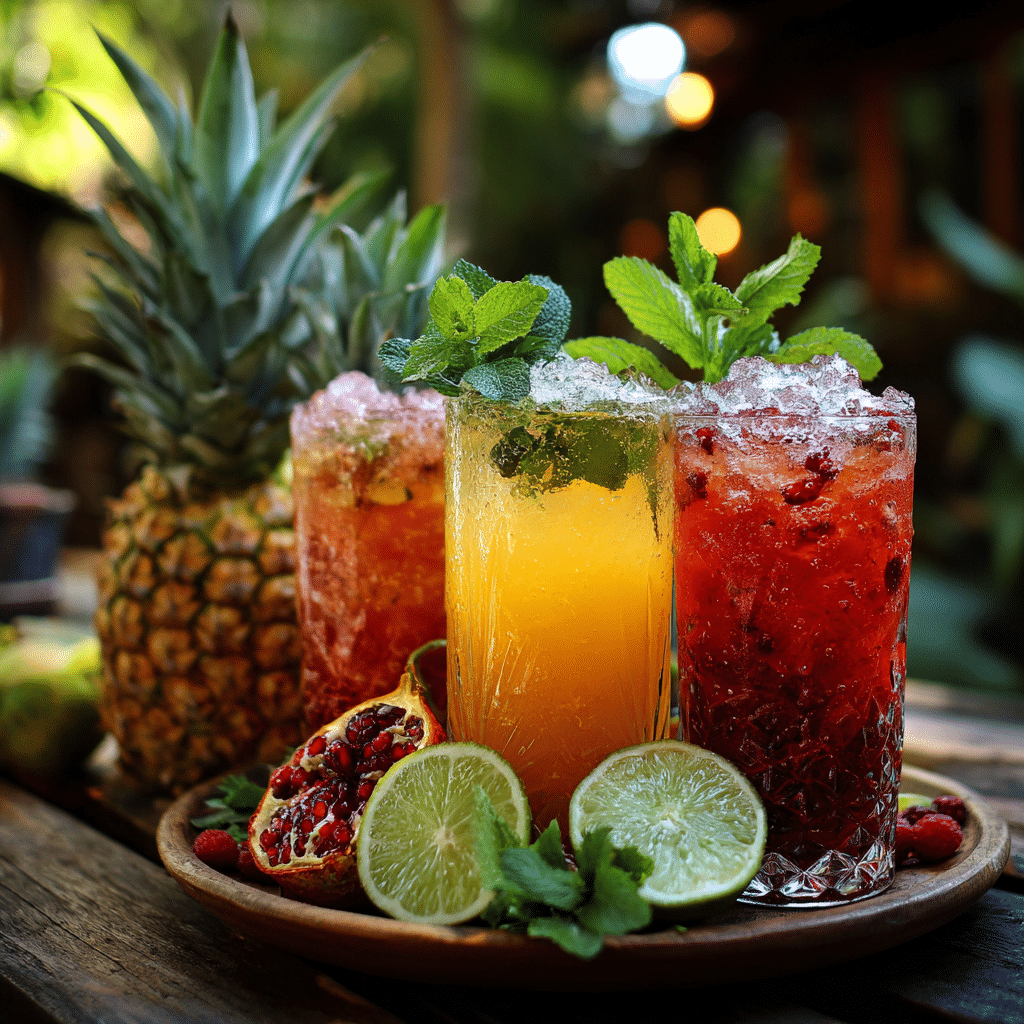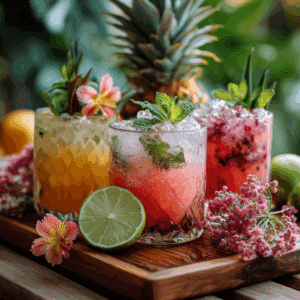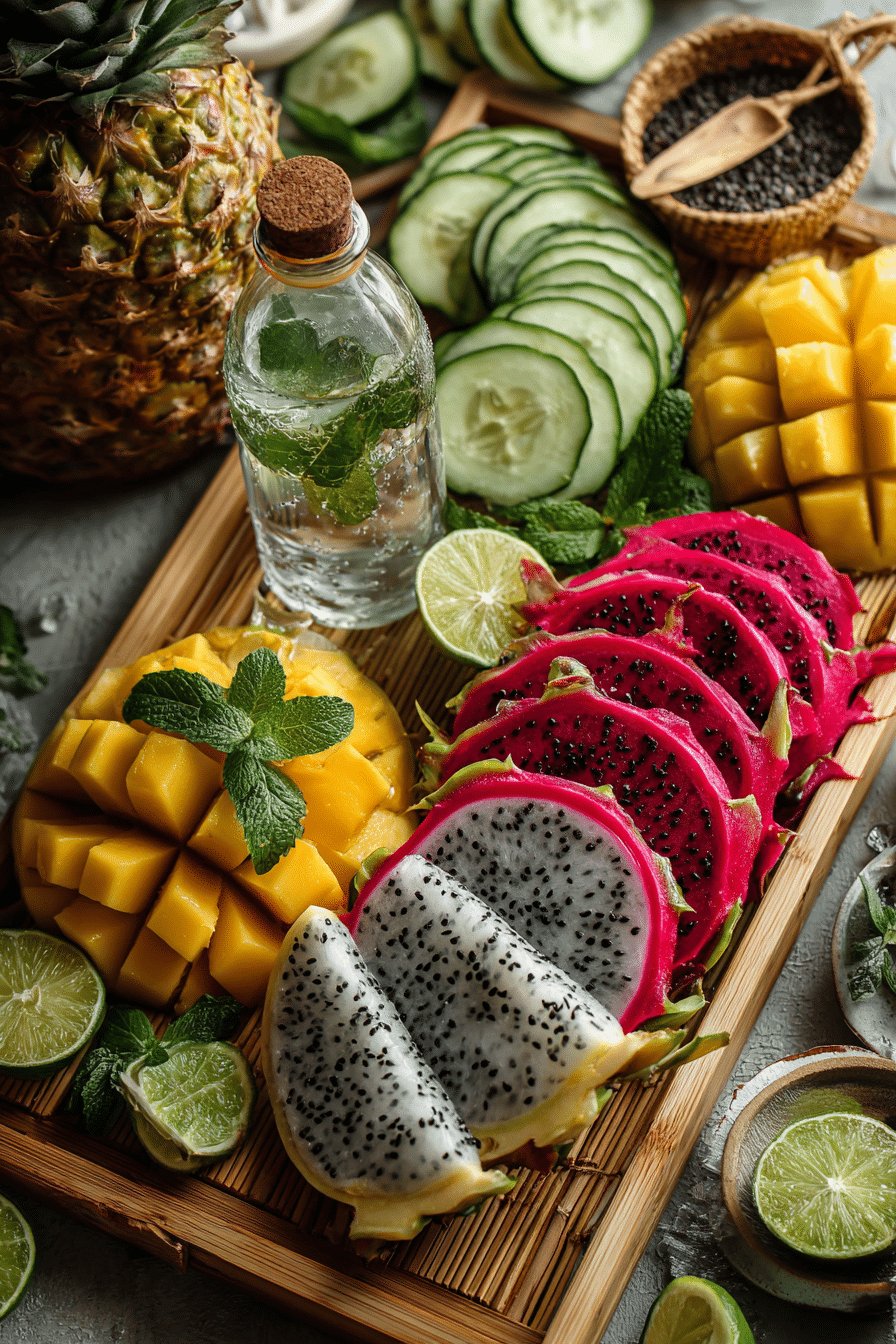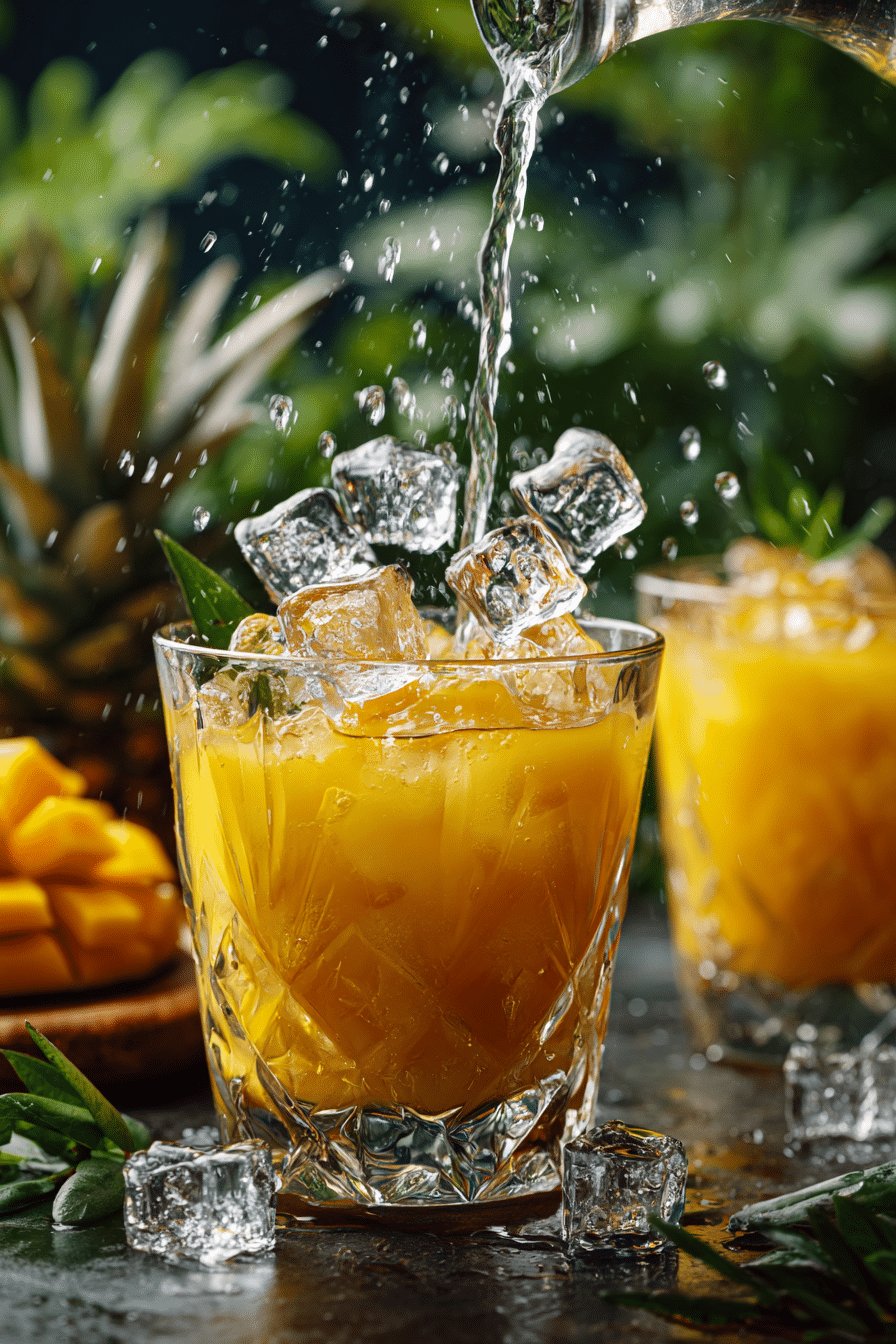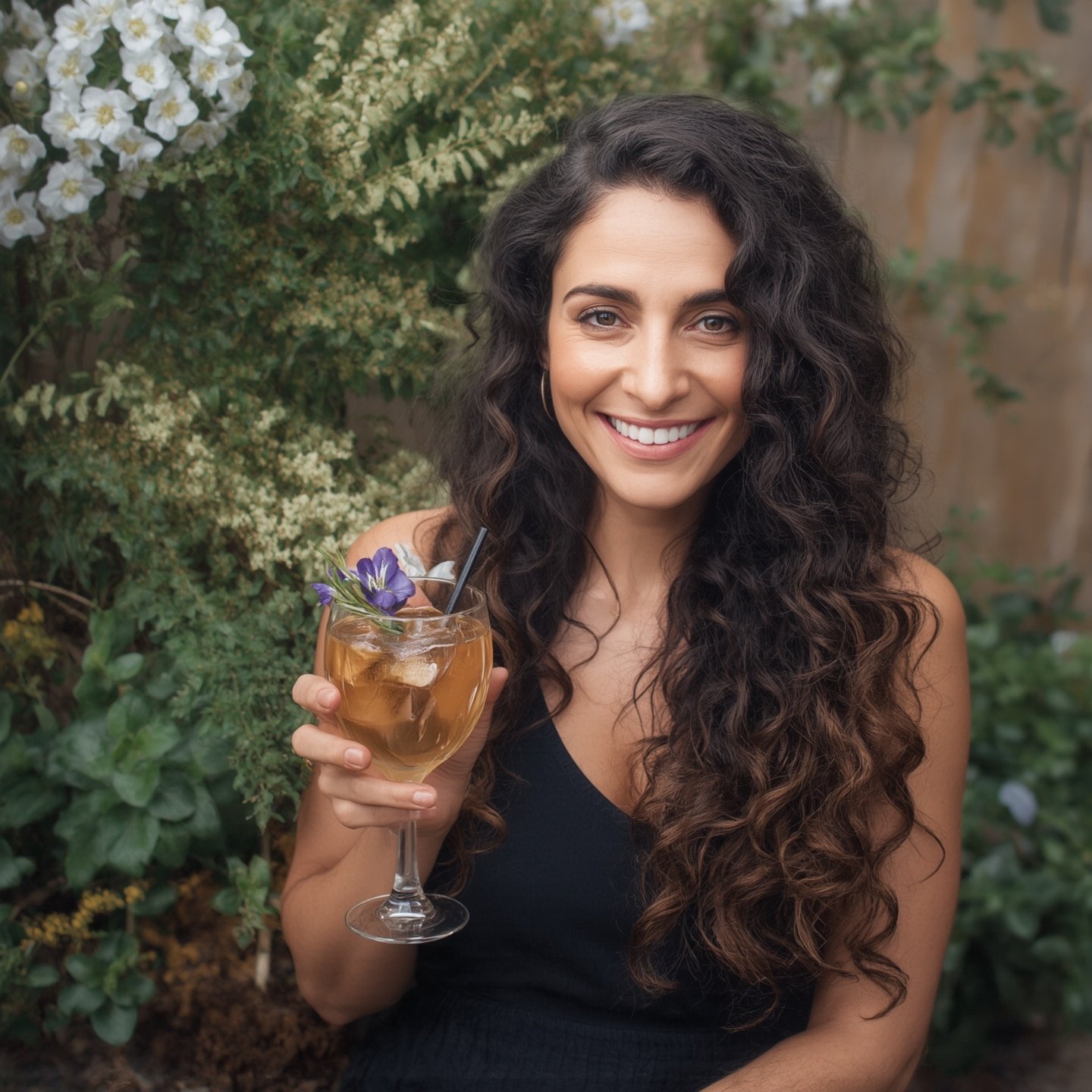If you’ve ever stood under the summer sun craving something juicy, fruity, and truly refreshing—only to be handed soda or lukewarm water—you’re not alone. That’s exactly how I felt during a family trip to Kennebunkport, Maine. Everyone had something festive in hand, and there I was with a plastic cup of flat seltzer. It hit me: hydration doesn’t have to be boring. That night, I started experimenting with hydrating tropical mocktails using fruits and herbs from the local farm stand. What I discovered was more than a thirst quencher—it was a whole new way to celebrate hydration. Here’s how you can do the same.
Table of Contents
Hydrating Tropical Mocktails
Equipment
- shaker or large glass
- mixing spoon
- serving glasses
- citrus juicer (optional)
Ingredients
- 200 ml coconut water
- 100 ml pineapple juice
- 60 ml fresh mango puree or juice
- 1 tbsp lime juice
- 1 tsp chia seeds (optional)
- 4–5 ice cubes
- 2–3 fresh mint leaves (optional)
Instructions
- In a large glass or shaker, add coconut water, pineapple juice, mango puree, and lime juice.
- Add chia seeds (if using) and stir well to distribute evenly.
- Fill a glass with ice cubes, then pour the mixture over the ice.
- Garnish with mint leaves and serve immediately.
- Stir gently before sipping to ensure flavors are well mixed.
Notes
Nutrition
Why Hydration Should Be Delicious
From Thirst to Tropics: My Summer on the Coast
Maine summers aren’t like the tropics, but the sun still has bite. That particular afternoon in Kennebunkport, the air was thick and salt-scented. A friend handed me a colorful drink—virgin, of course—made with mango, pineapple juice, and coconut water. I took a sip and felt an instant cool-down that water never quite delivers. That moment shaped how I now build every hydrating mocktail: tropical flavor first, hydration as the backbone.
I started blending fresh fruits like watermelon, papaya, and dragon fruit. I swapped soda water for electrolyte-rich coconut water. And I began to realize that mocktails weren’t just for parties—they could be the most satisfying part of any summer day.
This personal shift inspired a whole series of recipes I now call “Hydration Heroes,” like my go-to Tropical Punch Mocktail and Frozen Mango Daiquiri Mocktail. These drinks offer real function—like rehydration after a beach walk—without compromising flavor.
Why I Started Making Tropical Mocktails for Hydration
Before mocktails, I used to guzzle plain water and feel like I was doing something wrong—always bloated, never really refreshed. Once I started using tropical fruits and functional ingredients like cucumber, mint, and even chia seeds, everything changed.
What makes tropical mocktails perfect for hydration? It’s the balance of natural electrolytes, high-water fruits, and herbs that support fluid retention without puffiness. Think pineapple for bromelain, lime for vitamin C, and coconut water for potassium. Plus, when they’re pretty and satisfying, you’ll naturally drink more—without even realizing it.
That’s what I aim to show on every recipe page at Mocktaila: hydration doesn’t have to be forced. It should be crave-worthy. And when it comes in flavors like mango-lime or cucumber-lavender? Trust me—you’ll want more than one.
In the next section, I’ll break down the ingredients that do the real work behind these vibrant drinks.
Best Ingredients for Hydrating Tropical Mocktails
Hydrating Fruits That Do More Than Just Taste Good
Not all fruits are created equal—especially when hydrating tropical mocktails are the goal. Tropical fruits happen to be some of the most water-rich and mineral-packed ingredients you can sip. Let’s start with the star players:
- Watermelon: Over 90% water, and packed with lycopene and potassium.
- Pineapple: Juicy, vibrant, and loaded with bromelain—great for digestion and fluid retention.
- Mango: Slightly creamy, adds body to your mocktail, and brings fiber to the mix.
- Dragon Fruit: A stunning base for any drink. Lightly sweet, filled with antioxidants, and hydrating.
- Coconut Water: Technically not a fruit, but essential. It’s nature’s electrolyte blend.
These all work beautifully in hydrating tropical mocktails that both cool and energize. I love combining dragon fruit with citrus or adding a splash of pineapple and orange juice to brighten the drink while boosting hydration.
Another underused hero? Cucumber. While not tropical, it’s quietly hydrating and blends seamlessly into fruit-forward drinks.
What Makes an Ingredient “Hydrating” Anyway?
Hydration goes beyond just water content. Your body needs electrolytes (like potassium and magnesium) to hold onto that water. That’s why drinks made with coconut water, lime, sea salt, or chia seeds can keep you hydrated longer.
To make hydrating tropical mocktails that truly work, you need more than juice. Look for ingredients that provide both fluid and function. For example, the Healthy Low Sugar Tropical Mocktail uses basil and citrus with coconut water—it hydrates without spiking blood sugar or relying on artificial sweeteners.
Speaking of sweetness, choosing smart alternatives matters. Agave and processed syrups can create blood sugar crashes that counteract hydration. If you’re curious about better options, check out these sweeteners for tropical mocktails.
Here’s a quick cheat sheet I use when building hydrating tropical mocktails for events or everyday sipping:
| Ingredient | Hydration Power | Best Pairings |
|---|---|---|
| Coconut water | High in potassium | Mango, pineapple, cucumber |
| Lime | Electrolyte-boosting | Mint, coconut, passionfruit |
| Cucumber | Cooling, water-rich | Watermelon, basil, lemon |
| Papaya | Low sugar, high water | Lime, ginger, coconut water |
| Chia seeds | Retain moisture | Pineapple, citrus, mint |
Want to go deeper into the world of tropical hydration? You’ll love the flavor pairing tips in the Tropical Mocktails Guide. It’s packed with smart combos for building your own hydrating tropical mocktails at home.
Smart Recipes for Real Refreshment
Sugar-Free, Bloat-Free Tropical Sips
Let’s face it—many so-called “healthy” drinks are just fruit juice bombs with fancy names. When I started crafting hydrating tropical mocktails, my goal wasn’t just to make them look pretty. I wanted drinks that actually felt good an hour later.
The key? Skip the added sugars and focus on natural sweetness from fruits like mango, pineapple, and papaya. If more sweetness is needed, a splash of monk fruit syrup or a drizzle of raw honey does the trick without the crash.
One of my favorite recipes is this Tropical Sunrise Mocktail. It blends orange, pineapple, and coconut water for a vibrant layered drink that hydrates as it satisfies.
Another winner is my Frozen Mango Daiquiri Mocktail—a chilled, slushy-style drink made with frozen mango chunks, lime juice, and chilled coconut water. It’s one of the most requested recipes in my summer mocktail lineup.
These drinks avoid that sticky-sweet aftertaste and instead leave you feeling refreshed, not overloaded.
Mocktails That Beat Boredom (and Dehydration)
Staying hydrated shouldn’t feel like a chore. That’s why I treat every mocktail like a mood boost. Whether you’re lounging by the pool or working through emails, there’s always room for something fruity, fun, and functional.
One trick I use to keep things interesting is texture layering. Add chia seeds for a bubble-tea vibe or blend frozen fruit chunks for a spoonable finish. Another idea? Float fresh mint or basil leaves on top—not just for garnish, but for that cool herbaceous lift.
Here’s a 3-step formula I often follow when building hydrating tropical mocktails that people actually crave:
- Base: Coconut water or cucumber juice
- Body: Pineapple, mango, watermelon, or passionfruit
- Brightener: Lime juice, ginger, or a touch of salt
This combo works in a pitcher or a shaker, and it’s endlessly adjustable.
For more ideas like these, my post on tropical fruit juices has all the flavor combos you need to build a mocktail bar that keeps hydration exciting.
And remember: the goal isn’t just to look good on Instagram—it’s to feel good all day. These aren’t just party drinks; they’re part of my everyday wellness routine.
FAQs
What are the best tropical fruits for hydrating mocktails?
The best tropical fruits for hydrating tropical mocktails are those with high water content and natural electrolytes. Think pineapple, mango, watermelon, dragon fruit, papaya, and passionfruit. Each brings something unique—pineapple adds zing, mango adds body, and watermelon cools and hydrates fast. Blend them with coconut water, and you’ve got a mocktail that’s both delicious and functional. You’ll find these ingredients used again and again in recipes like the Tropical Punch Mocktail that’s a hit at beach parties and BBQs.
Are tropical mocktails good for staying hydrated in summer?
Absolutely. When made right, tropical mocktails do more than satisfy your sweet tooth—they support real hydration. Drinks with ingredients like coconut water, lime, and water-rich fruits provide both fluids and minerals. They’re a much better summer choice than sugary sodas or plain juice. For more inspiration on beating the heat, I recommend my Hydrating Tropical Mocktails Guide, which breaks down ingredient pairings and hydration tips for every taste.
Can I make hydrating tropical mocktails without added sugar?
Yes—and you should! The natural sweetness of tropical fruits often means you don’t need to add anything else. Mango, ripe pineapple, or orange juice can carry the flavor beautifully. For those who prefer a touch more sweetness, monk fruit, stevia, or a date syrup work well without compromising the health benefits. A great place to start is this Healthy Low Sugar Tropical Mocktail, which blends fresh herbs and citrus with coconut water for a guilt-free refresher.
What ingredients boost hydration in alcohol-free drinks?
The MVPs of hydration in non-alcoholic drinks are coconut water, cucumber juice, chia seeds, lime, and even a pinch of sea salt. These ingredients do more than add flavor—they support electrolyte balance and help your body retain water. When building hydrating tropical mocktails, I focus on combining water-rich fruits with at least one of these boosters. Want to learn more about balancing flavors and hydration? My Tropical Mocktails Guide is packed with ideas.
Conclusion: Sip Your Way Into Hydrated Paradise
Mocktails don’t have to be second-best. When made with purpose, they can fuel your body and spirit—especially in summer, when hydration matters most. Whether you’re blending up mango, muddling mint, or shaking coconut water with lime, these hydrating tropical mocktails offer more than a pretty glass. They give you flavor, function, and a reason to skip the alcohol without sacrificing joy.
So next time the sun hits hard, ditch the bottled sports drinks and make something that truly refreshes. Trust your tastebuds—and your body will thank you.

